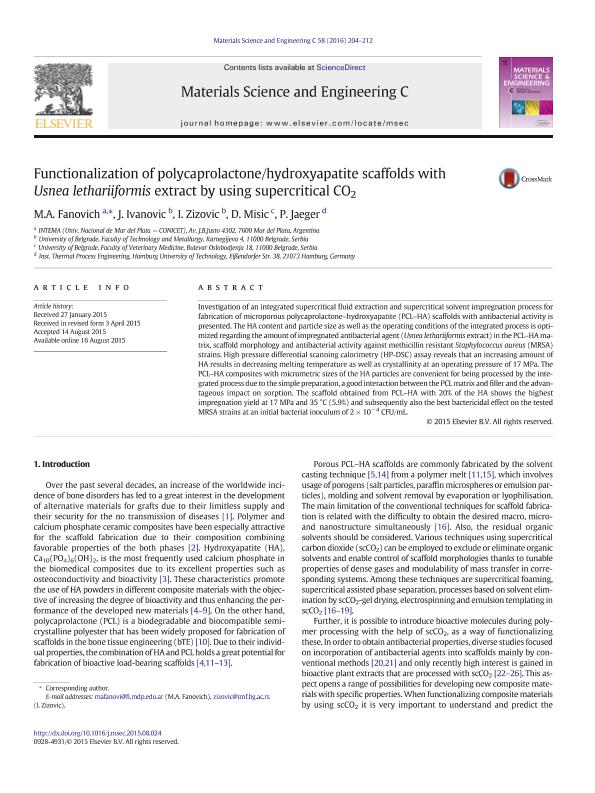Mostrar el registro sencillo del ítem
dc.contributor.author
Fanovich, Maria Alejandra

dc.contributor.author
Ivanovic, J.
dc.contributor.author
Zizovic, I.
dc.contributor.author
Misic, D.
dc.contributor.author
Jaeger, P.
dc.date.available
2018-03-22T15:19:06Z
dc.date.issued
2016-01
dc.identifier.citation
Fanovich, Maria Alejandra; Ivanovic, J.; Zizovic, I.; Misic, D.; Jaeger, P.; Functionalization of polycaprolactone/hydroxyapatite scaffolds with Usnea lethariiformis extract by using supercritical CO2; Elsevier Science; Materials Science and Engineering: C; 58; 1-2016; 204-212
dc.identifier.issn
0928-4931
dc.identifier.uri
http://hdl.handle.net/11336/39635
dc.description.abstract
Investigation of an integrated supercritical fluid extraction and supercritical solvent impregnation process for fabrication of microporous polycaprolactone-hydroxyapatite (PCL-HA) scaffolds with antibacterial activity is presented. The HA content and particle size as well as the operating conditions of the integrated process is optimized regarding the amount of impregnated antibacterial agent (Usnea lethariiformis extract) in the PCL-HA matrix, scaffold morphology and antibacterial activity against methicillin resistant Staphylococcus aureus (MRSA) strains. High pressure differential scanning calorimetry (HP-DSC) assay reveals that an increasing amount of HA results in decreasing melting temperature as well as crystallinity at an operating pressure of 17 MPa. The PCL-HA composites with micrometric sizes of the HA particles are convenient for being processed by the integrated process due to the simple preparation, a good interaction between the PCL matrix and filler and the advantageous impact on sorption. The scaffold obtained from PCL-HA with 20% of the HA shows the highest impregnation yield at 17 MPa and 35 °C (5.9%) and subsequently also the best bactericidal effect on the tested MRSA strains at an initial bacterial inoculum of 2 × 10- 4 CFU/mL.
dc.format
application/pdf
dc.language.iso
eng
dc.publisher
Elsevier Science

dc.rights
info:eu-repo/semantics/openAccess
dc.rights.uri
https://creativecommons.org/licenses/by-nc-sa/2.5/ar/
dc.subject
Scaffolds
dc.subject
Polycaprolactone
dc.subject
Supercritical Fluid
dc.subject.classification
Recubrimientos y Películas

dc.subject.classification
Ingeniería de los Materiales

dc.subject.classification
INGENIERÍAS Y TECNOLOGÍAS

dc.title
Functionalization of polycaprolactone/hydroxyapatite scaffolds with Usnea lethariiformis extract by using supercritical CO2
dc.type
info:eu-repo/semantics/article
dc.type
info:ar-repo/semantics/artículo
dc.type
info:eu-repo/semantics/publishedVersion
dc.date.updated
2018-03-21T16:03:22Z
dc.journal.volume
58
dc.journal.pagination
204-212
dc.journal.pais
Países Bajos

dc.journal.ciudad
Amsterdam
dc.description.fil
Fil: Fanovich, Maria Alejandra. Consejo Nacional de Investigaciones Científicas y Técnicas. Centro Científico Tecnológico Conicet - Mar del Plata. Instituto de Investigaciones en Ciencia y Tecnología de Materiales. Universidad Nacional de Mar del Plata. Facultad de Ingeniería. Instituto de Investigaciones en Ciencia y Tecnología de Materiales; Argentina
dc.description.fil
Fil: Ivanovic, J.. University of Belgrade; Serbia
dc.description.fil
Fil: Zizovic, I.. University of Belgrade; Serbia
dc.description.fil
Fil: Misic, D.. University of Belgrade; Serbia
dc.description.fil
Fil: Jaeger, P.. Universitat Hamburg; Alemania
dc.journal.title
Materials Science and Engineering: C

dc.relation.alternativeid
info:eu-repo/semantics/altIdentifier/doi/http://dx.doi.org/10.1016/j.msec.2015.08.024
dc.relation.alternativeid
info:eu-repo/semantics/altIdentifier/url/https://www.sciencedirect.com/science/article/pii/S0928493115302794
Archivos asociados
